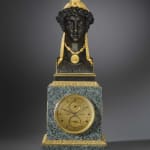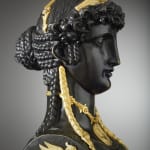Basile-Charles Le Roy
Provenance
Probably acquired from Basile Le Roy by his patron Jérôme Bonaparte, King of Westphalia, and thence to his daughter Mathilde Bonaparte, who married Anatole Demidoff 1st Prince di San Donato. Sold with the remaining contents from the Villa Demidoff, Pratolino, near Florence, sold by order of H.R.H. Prince Paul of Yugoslavia (son of Aurora Pavlovna Demidoff, Princess di San Donato, grandson of Paul Pavlovich Demidoff, 2nd Prince di San Donato and great great nephew of Mathilde and Anatole Demidoff), sold by Sotheby's London, 22nd April 1964, lot 226. Acquired at the sale or later by Edward and Kiyi Pflueger.
Literature
Contents from Villa Demidoff, Pratolino, near Florence, sold by order of H.R.H. Prince Paul of Yugoslavia, Sotheby's London, sale catalogue, 21-24th April 1969, lot 226, illustrating this clock. Pierre Kjellberg, "Encyclopédie de la Pendule Française du Moyen Age au XXe Siècle", 1997, p. 414, pl. C, illustrating a similar clock by Basile-Charles Le Roy.
A very important and fine Empire gilt and patinated bronze and green porphyry mantel clock signed and numbered on the movement No. 547/ Leroy/ Hger……/Au Palais Royal/ Nos 13 et 14. A Paris, (the central part of the inscription later effaced), the circular brass dial set within a porphyry plinth with Roman chapter ring and a matted centre with two subsidiary rings for the date and days of the week, with a pair of blued steel Breguet style hands for the hours and minutes and blued steel pointers for the calendar indications. The movement accessed below the surmounting detachable bronze bust with twin barrels, silk thread suspension and striking on a single bell. The whole surmounted by a bronze bust of a Classical Greek woman wearing an Imperial diadem, braided hair and an ornate necklace centred by a medallion featuring the head of Socrates, mounted to each side with chimerae, the bust on a stiff-leaf cast border, upon a green granite plinth previously set at the sides with further mounts
Paris, date circa 1810
Height 53 cm.
The clock cited in Kjellberg, ibid, signed on the movement Basile-Charles Le Roy, shares many similarities with the present example. The same maker made both movements; the dials are also identical as is the shape of the plinth though the former was made from red porphyry rather than as here from green porphyry. In addition this clock features a classical female bust while the other a portrait of Napoleon's sister princesse Elisa Baciocchi, grande-duchesse of Tuscany, who gave her clock to the Empress Marie-Louise on the occasion of her marriage to Emperor Napoleon in 1810. Interestingly the sides of the latter clock are mounted with Imperial coats of arms; judging from the size of the filled-in holes on the sides of the present plinth as well as the strong probability that it was commissioned by Jérôme Bonaparte, King of Westphalia, this clock may also have once born similar mounts (the mounts probably having been removed at the same time as part of the inscription on the movement was effaced).
The Elisa clock, inscribed Dumont sculpt 1810, was almost certainly modelled by the sculptor Jacques Edme Dumont (1761-1844), after a portrait sculpture by Joseph Chinard (1756-1813). It is probable that the present bust was also by Dumont since her features and hairstyle are very similar to the sculptor's female figure used in one of his projects for a fountain (Musée du Louvre).
Both clock movements were made by the esteemed maker Basile (also known as Bazile)-Charles Le Roy (1765-1839), who was born in Paris, the son of the clockmaker Bazile Le Roy (1731-1804). Basile-Charles founded the House of Le Roy at 60 Galerie de Pierre, Palais-Royal shortly after 1785 when the duc d'Orléans (Philippe Egalité) opened up the Palais-Royal gardens to the public and the buildings to the trade. This enabled Le Roy and a number of other clockmakers to set up shop in the arcade galleries. During the Revolution he worked for the Republic signing his clocks 'Elyor'. Afterwards he moved the business to Galerie Montpensier, 13-15 Palais-Royal, where the concern was to remain for almost a hundred years.
The following years saw his appointment as clockmaker to Emperor Napoleon, to Madame Mère, Princess Pauline, Jérôme Bonaparte King of Westphalia and in 1829 as royal clockmaker to the ducs de Bourbon and de Chartres. His house exhibited clocks at the Paris Exposition l'an VI (1797/8) and again in 1819, 1823 and 1827. Basile-Charles Le Roy was highly innovative taking out a patent for one of his atmospheric clocks in 1823. In addition to this wonderful example, two other mantle clocks by him can be seen at the Ministère de la Guerre, Paris. When his son Charles-Louis (also known as Louis-Charles, 1794-1865/66) went into partnership with him in 1828 the business was renamed Le Roy et Fils. Charles-Louis proved equally successful in running the concern and in 1835 was appointed Horloger du Roi and Horloger du Ministère de la Marine.
This superb clock comes with a very important provenance. It was included in the sale of the remaining contents from the Villa Demidoff, Pratolino about 15 kms north of Florence. The sale was by order of H.R.H. Prince Paul of Yugoslavia (1893-1976), who had inherited the estate at Pratolino, originally acquired in 1872 by his maternal grandfather Paul Pavlovich Demidoff, 2nd Prince di San Donato (1839-85). The sale ran for four days from 21st-24th April 1969. Prince Paul Karageorgievich Grand Duke, Prince Regent of Yugoslavia from 1934-1941, was the son of Arsene Karageorgievich, Prince of Serbia (1859-1938) and Aurora Pavlovna Demidoff, Princess di San Donato (1873-1904).
Before moving to Pratolino, Prince Paul's grandfather Paul Pavlovich had lived at Villa San Donato, also near Florence. That palatial residence had been built by his maternal grandfather Count Nicholas N. Demidoff (1773-1828) where both Paul Pavlovich's father Paul N. Demidoff (1798-1840) and uncle Anatole Demidoff (1813-70) had spent some of their childhood. Paul N. Demidoff's son, Paul Pavlovich was also raised at Villa San Donato and continued to live there with his much loved new wife Princess Marie Elimovna Metscherskii (1844-68), but sadly she died during childbirth.
When Paul Pavlovich remarried Princess Helene Petrovna Troubetzkoi (1853-1917), his new wife persuaded him to move to Pratolino to escape his painful associations with Villa San Donato. When they purchased the Pratolino estate in 1872, much of the sixteenth century Medici palatial villa, (designed by the architect Bernardo Buontalenti for Ferdinando I, son of Cosimo III), had either fallen into ruin or had been pulled down so Paul Pavlovich restored the paggeria (built for the Medici household staff) to use as his residence. From there he and his new wife could enjoy the extensive grounds covering some 74 acres, that included many of the original sixteenth century waterworks, man-made caves and sculptures. Among notable works still remaining is the massive Appenine, a colossal cyclopic sculpture by Giambologna (1579), the flight of steps with the fountain of Pan and Buontalenti's octagonal chapel. The gardens are now open to the public while the paggeria has recently been restored to be used for exhibitions and conferences.
The Sotheby's sale catalogue of 1969 noted that the clock had probably been firstly acquired by Jérôme Bonaparte, King of Westphalia (1784-1860), and was in turn owned by his daughter Princess Mathilde (1820-1904) and her husband Anatole Demidoff, 1st Prince di San Donato Jérôme was the youngest brother of Emperor Napoleon and given that we know the other almost identical Le Roy clock was acquired by Napoleon's sister Elisa Baciocchi, it would have been fitting that the present example was acquired by another of Napoleon's siblings, especially as Jérôme Bonaparte was one of Basile-Charles Le Roy's great patrons. Born in Corsica, Jérôme Bonaparte served with the French navy before embarking to the United States, where he met his first wife, Elizabeth Patterson, daughter of a Baltimore merchant. They had one son but the marriage was not happy and was subsequently annulled by Napoleon leaving Jérôme free to remarry Catharina of Württemberg by whom he had a son, Napoleon Joseph Charles Paul and then a daughter, Princess Mathilde Bonaparte.
Born in Trieste, Mathilde was raised in Florence and Italy and grew into a vivacious society beauty. After two years of complex negotiations a marriage was arranged between her and Anatole Demidoff di San Donato, 1840. Anatole was the younger of the two sons of Count Nicholas N. Demidoff and Baroness Elisabeth Alexandrovna Stroganoff (1779-1818). Having lost both parents while still young, he and his much older brother Paul Demidoff (1798-1840) assumed control of the Demidoff Russian mining and arms empire and ensured its continuing success He proved an astute businessman and keen scientist whose immense wealth allowed him to pursue a passion for the arts and to commission leading artists such as Eugene Delacroix and Paul Delaroche as well as silversmiths and jewellers.
He was however less fortunate in his marriage, which only lasted six years, resulting in no children and bitter recriminations on both sides. Anatole enjoyed a life long interest in the Napoleonic heritage and if assuming the clock came into the Demidoff family through Anatole's wife Mathilde, it may have been included among a number of other works of art that he purchased from his future father-in-law prior to his marriage to Mathilde as part of a highly complex pre-nuptial agreement that was to help Jérôme pay off some of his debts. Among such objects Anatole purchased from Jérôme a statue of the Emperor for 11,000 francs and statues of Jérôme and Madame Mère for 10,000 francs each, which he installed at the Villa San Donato. Since Anatole and Mathilde had no heirs, the majority of Anatole's collection passed onto his nephew Paul Pavlovich Demidoff but much of it, along side many other of the Demidoff works of art, was sold over a six week period in 1881 when the Villa San Donato and its contents were put up for auction. If assuming the clock was once owned by Mathilde and Anatole, it was one of the objects that was not included in that sale.
Paul Pavlovich and his second wife Helene had six children, the eldest surviving one being Aurora Pavlovna Demidoff, Princess di San Donato, who in 1892 married Arsene Karageorgievich, Prince of Serbia but later divorced in 1896. They had one son Paul Karageorgievich, Prince of Yugoslavia. Born at St. Petersburg and later educated at Oxford University, he was considered to have a British outlook on life. Indeed his best man at his wedding in 1923 to Princess Olga of Greece and Denmark (sister of Princess Marina, Duchess of Kent) was the Duke of York, later King George VI of England. Prince Paul assumed regency of Yugoslavia in 1934 following the assassination of his cousin King Alexander and ruled the country until 1941. With the invasion of Hitler, Prince Paul and other members of the royal family escaped; he spent the rest of WWII in South Africa and eventually died in Paris in September 1976, never having returned to Yugoslavia.
Shortly before his 76th birthday Prince Paul organised the sale of this clock and many other fine works from the Villa Demidoff. The clock then entered the collection of Kiyi (Kathleen Isabel née Powers; d. 2006) and her husband Edward M. Pflueger (d. 1997). Both were great connoisseurs and keen art collectors. Together they amassed one of the finest privately held sixteenth and seventeenth century faience and eighteenth century porcelain collections much of which was bequeathed to the Museum of Fine Arts Boston; they also owned a fine collection of Chinese ceramics. Kiyi was on the board of the East Side Settlement House, a community resource in the South Bronx to enable further education for the young and was in particular one of the founding members involved in the annual Winter Antiques Shows, which helped fund the programme. Their clock is a work of art in its own right but has gained even greater importance on account of its esteemed provenance.



